Laser Produced Plasmas as a Compact Particle Accelerator
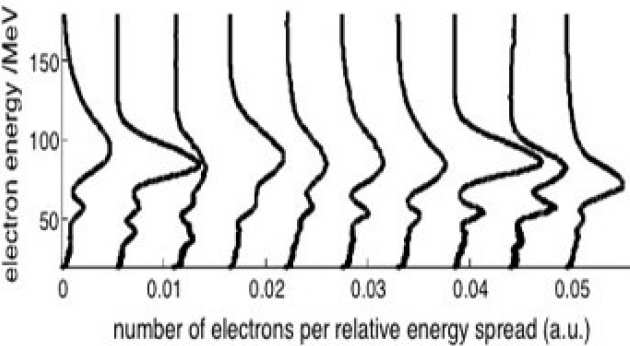 Z. Najmudin, A. E. Dangor, S. Mangles, L. Willingale, C. Kamperidis, S. Nagel, C. Bellei, C. Palmer, A. Rehman
Z. Najmudin, A. E. Dangor, S. Mangles, L. Willingale, C. Kamperidis, S. Nagel, C. Bellei, C. Palmer, A. Rehman
High intensity laser produced plasmas are capable of accelerating particles to high energies over very short distances. Our group was the first to demonstrate that mono-energetic electron beams could be produced by this method (Nature 2004). Recently, we have been able to demonstrate that the laser beam is able to drive the accelerating structure, called a wakefield, over a distance greater than the length over which it would normally propagate because it is constrained from defocusing by the wakefield. As the beam propagates it changes from being circular in cross section to being slightly elliptical, which indicates that the electron beam is initially generated behind the laser beam but as it accelerates moves forward, it gains energy from the electric field of the laser. Broadband radiation, meanwhile, is emitted transverse to the motion of the electrons when they are initially trapped and accelerated.
Experiments relevant to laser Fusion Studies
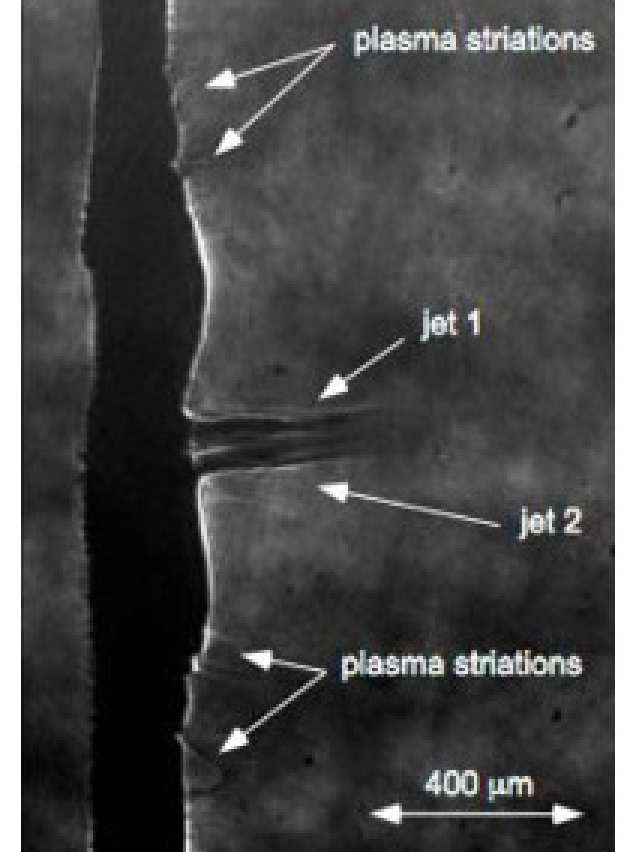 Z. Najmudin, A. E. Dangor, S. Mangles, L. Willingale, C. Kamperidis, S. Nagel, C. Bellei, C. Palmer, A. Rehman
Z. Najmudin, A. E. Dangor, S. Mangles, L. Willingale, C. Kamperidis, S. Nagel, C. Bellei, C. Palmer, A. Rehman
We have studied the physics of neighboring laser produced plasmas, such as those generated by the multiple beam heating systems in ICF experiments. Each laser – target interaction produces a plume of plasma with an azimuthal magnetic field. We have made the first measurements of magnetic reconnection between the magnetic fields of adjacent plasma plumes. The reconnection results in extraneous heating of a collision region far separated from the laser sources that could affect the illumination and symmetry of ICF targets.
Another area of research has been the production and transport of high current, relativistic electron beams for use in fast ignition ICF. In this scheme, long pulse drive lasers compress a DT fuel capsule, then a high intensity laser pulse is used to produce an e-beam that provides sufficient energy to ignite the fuel. We have measured the transport of hot electrons through a solid target by studying the optical radiation that is produced when the electrons exit the target.
Figure (left) : Jets due to magnetic reconnection (between 2 laser heated spots)
Recent Work
- Generation of Ion Beams with Lasers
- Research on ICF
- Magnetised Plasmas, Magnetic Reconnection and Implications for Inertial Confinement Fusion
- Computer Simulations of High Intensity Laser Interactions
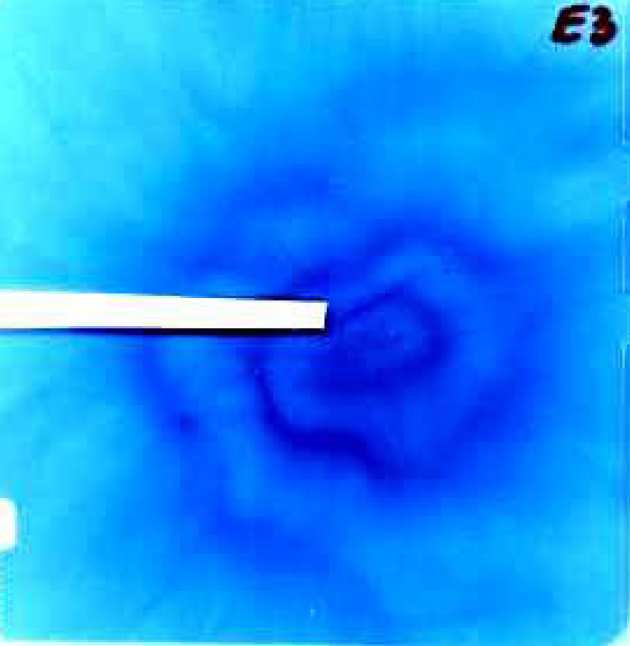 Charlotte Palmer
Charlotte Palmer
The development of chirped pulse amplification (CPA) techniques has made possible the production of high intensity, short duration laser pulses which can be used to generate energetic beams of ions by interaction with a target. Ions are accelerated by electric fields of TV/m resulting from space charge separation of hot electrons and have been recorded to reach energies of approximately 60MeV (I>1020W/cm2). These energetic ions can potentially be used for a wide range of applications. Applications include a high spatial and temporal resolution probe to measure the time dependent electric and magnetic fields in dense plasmas, imaging and treatment of cancerous tumours as well as a compact ion source for the production of isotopes used in nuclear medicine. Groups of scientists from Imperial, in collaboration with scientists across Europe, have investigated the generation of ion beams from both underdense and overdense plasmas: including shock acceleration; induced electric fields and ponderomotive force acceleration along with the more commonly investigated acceleration mechanism, target normal sheath acceleration (TNSA). Research is also being conducted into other factors such as the effect of target composition.
Figure (right): An unusual ring feature in a proton beam, recorded on radiochrome film (RCF)
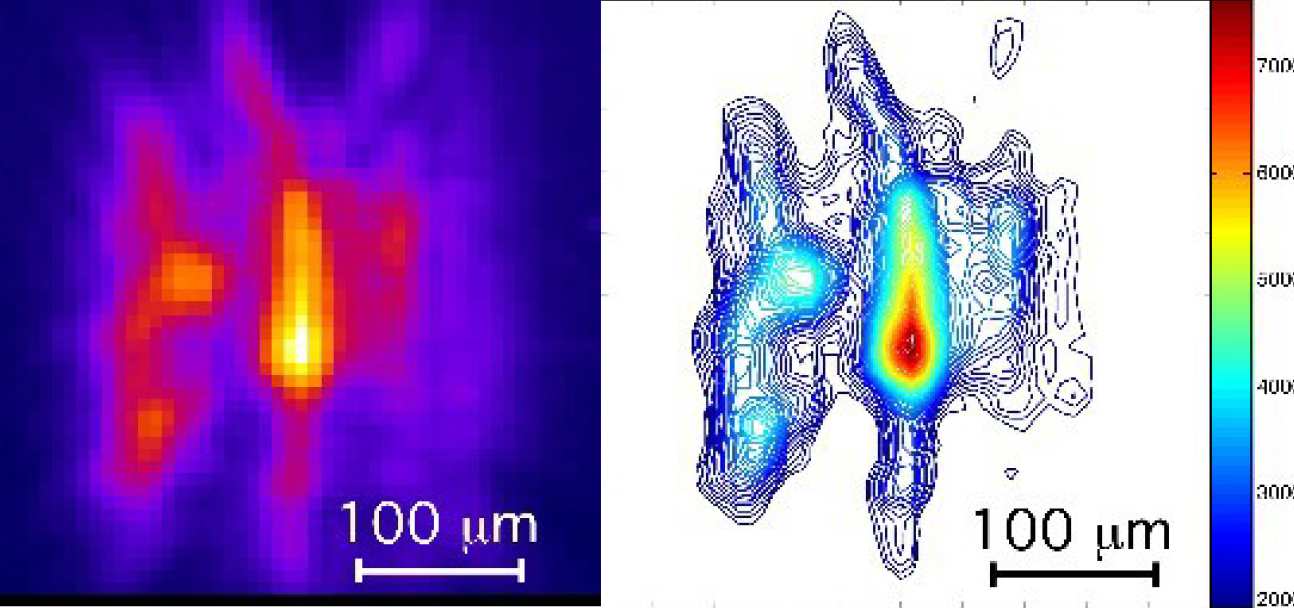 Claudio Bellei
Claudio Bellei
The group of experimental laser-plasma interaction is actively involved in the research for the production of energy via inertial confinement fusion (ICF). In the original scheme, called “central ignition”, a small (diameter of about 2 mm) spherical pellet made of Deuterium and Tritium (DT) is uniformly shined by a number of laser pulses to make the pellet undergo a spherical implosion. As a result part of the laser energy is transformed into kinetic energy of the imploding shell. At the end of the implosion the kinetic energy of the imploded shell is partially converted into internal energy and a hot temperature DT plasma is formed. If the temperature, density and mass of the hot plasma are high enough a self-sustained burning wave is produced and a sensible fraction (> 15-20 %) of the total DT atoms undergo fusion reactions. The net result is that more energy is released (mainly in the form of energy of the neutrons produced in the fusion reactions) than the initial energy of the laser driver.
Two large facilities are being built around the world to test the feasibility of this approach. In the US the National Ignition Facility (NIF) is planned to demonstrate ignition by 2009. In France, the Laser Megajoule (LMJ) is expected to be completed in 2010.
An alternative approach to central ignition is also currently studied. This approach, called Fast Ignition (FI), will allow to reach fusion in a cheaper way and is therefore a step forward for a commercial reactor. In this scheme ignition is achieved in two stages: in a first stage the pellet is again compressed to high densities. However this time the energy delivered to the target is not sufficient for producing the burning wave. The “spark” that gives rise to the burning wave is in fact produced in a second stage, where a ultra-intense laser beam either produces a beam of electrons or protons to “ignite” the DT plasma.
The first experimental facility to test the concept of Fast Ignition, called HiPER, has already been included in the European Strategy Forum on Research Infrastructures (ESFRI) roadmap that lists 35 opportunities for major science facilities over the next 20 years. Scientists from several institutions across Europe, including Imperial College, are contributing to this project.
Figure (above right): Experimental image of the optical transition radiation (OTR) produced in a high intensity laser-solid interaction, and [right] its contour plot . This radiation is emitted when the relativistic electrons produced in such interactions escape the interface solid(plasma)-vacuum and can give informations on the transport of these particles in the material. A better understanding of electron transport in high density plasmas is a crucial issue for the success of the fast ignition approach to inertial confinement fusion.
Louise Willingale
The density and temperature gradients in plasma generated by a laser interacting with a solid target lead to a self-generated magnetic fields directed azimuthally around the laser spot. These magnetic fields can be as large as several Megagauss. Under certain conditions, the outflowing plasma can carry out the magnetic field away from the focal spot. Positioning two laser focal spots at a suitable separation, can lead to a situation where there are two opposing magnetic fields in the region between the spots. This is a magnetic reconnection geometry and signature of a reconnection event have been observed in experiments. Pairs of high velocity jets were observed to emanate from the reconnection region. Electron temperature measurements using a Thomson scattering diagnostic show fast, strong heating of the electrons in the reconnection region from released magnetic energy. Measurements of the magnetic field can also be directly made using proton deflectometry probing. The production of the jets due to magnetic reconnection may also be of interest to scaleable astrophysical situations where high Mach number jets are observed.
Inertial confinement fusion is a method being considered to harness fusion energy. A hollow, spherical DT pellet is compressed to high density and temperature so that the fuel ignites and a burnwave consumes the fuel and energy is released from the fusion reactions. The compression can either be driven directly by lasers focused onto the surface of the pellet, or indirectly by focusing the lasers into a holraum to generate a high-pressure, uniform x-ray source. Both of these require the lasers to be focused close together, meaning that the interaction of the self-generated magnetic fields may be important to the dynamics of the interaction.
Stuart Mangles
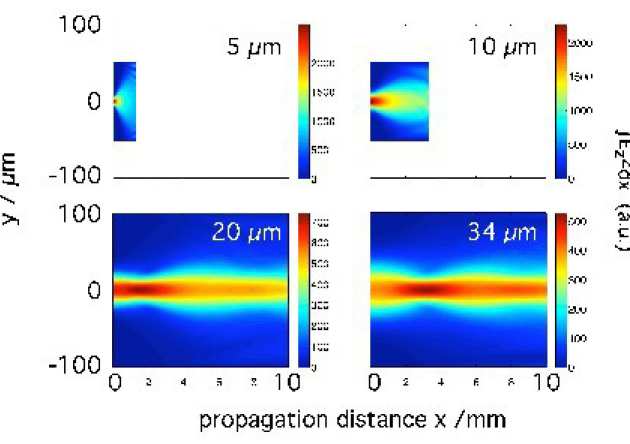 Experiments in laser-plasma interactions are in general complex to diagnose and analyse. To aid our understanding of our experiments and to help design future experiments we use computer modeling techniques. We mostly use a code called Osiris developed by our collaborators at UCLA and IST Portugal. Osiris is a particle-in-cell (PIC) code, these work at a fundamental level by solving Maxwell's equations and the relativistic equation of motion for charged particles. The fields are calculated by averaging the particle positions and momenta over grid cells. The separation into grid cells means PIC cod es are very efficient to run on large parallel computers - we have our own linux cluster 'Caesar' and access to the Imperial College high performance computer 'CX1'.
Experiments in laser-plasma interactions are in general complex to diagnose and analyse. To aid our understanding of our experiments and to help design future experiments we use computer modeling techniques. We mostly use a code called Osiris developed by our collaborators at UCLA and IST Portugal. Osiris is a particle-in-cell (PIC) code, these work at a fundamental level by solving Maxwell's equations and the relativistic equation of motion for charged particles. The fields are calculated by averaging the particle positions and momenta over grid cells. The separation into grid cells means PIC cod es are very efficient to run on large parallel computers - we have our own linux cluster 'Caesar' and access to the Imperial College high performance computer 'CX1'.
On the right we show some results from a set of simulations of our forthcoming experiment on the Astra Gemini laser at RAL on electron acceleration.
To get good electron acceleration we need the laser pulse to maintain a high intensity in the plasma over a long distance (about 1 cm). In vacuum the tightly focused laser pulse would diffract after about a millimetre. In the plasma a proce ss called self-f ocusing can counteract the diffraction to produce guiding - similar to how an optical fibre works. We performed these simulations to help us design the experiment by examining the effect of varying the size of the laser focus on the guiding of the laser in the plasma. Each figure represents the transverse profile of the laser pulse as it propagate through the plasma for different focal spot sizes.
The smallest spot sizes quickly diffract but the larger ones are guided over a centimetre.